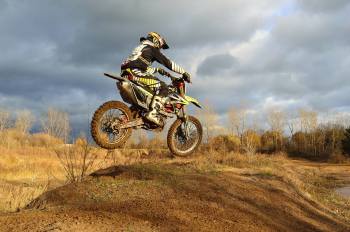How to choose the right off-road motorbike for you
Posted on
Seasoned bikers who know their Ricky Carmicheals from their Mika Aholas may be able to talk until the cows come home about the differences between a trials bike, an endurance bike and a motocross bike. But if you’re a little newer to the scene – or your own two-wheeled interests are usually in the field of choppers and bobbers – knowing which off-road motorbike is going to be your style can be a little harder to figure out.
Are you planning on riding tracks or trails, or setting off on Green Lane adventures? Whatever your pleasure, whether everyday practice or weekend warrior, here are a few key differences between off-road motorbikes to help you choose the right one for you.
Motocross Bikes vs Supermotos 
Motocross and Supercross are very similar sports with one key difference: Supercross takes place in arenas and stadiums, while Motocross takes place out in naturally occurring terrain. Both use dirt tracks, and in either sport the dirt tracks have been man-made for purpose, but the difference between arena dirt track and out-on-the-land dirt track is enough to warrant a different style of tyre and suspension.
In either sport, bikes need to be capable of making tight turns and big jumps. But while supermotos feature road tyres and soft suspension set-ups that make them suited to well-maintained routes, motocross bikes are more about the off-road. If you’re planning on going Green Laning and need guarantees that your bike will tolerate bumpier terrain, a motocross bike or enduro bike might be the one for you. But if your focus is on the track and you also need a daily ride, a supermoto can offer that flexibility. That’s not to say they’re all street legal – but it’s easier to make a supermoto street legal than it is to get an MX bike on the road.
Trials Bikes vs Trail Bikes
Trials bikes and trail bikes, aren’t they the same thing? Well, no. Most noticeably because trials bikes don’t have seats.
Trail bikes are incredibly similar to motocross bikes in just about every way, though motocross bikes are lighter because they’re designed to be track-raced. They’re both great for going off-road on tracks that aren’t manicured specifically for motorsports, but a motocross bike will need some accessorising to protect it from the roughest terrain – whereas a trail bike will take Green Lanes with ease. Trail bikes, often being designed more for fun and games than for competitive sport, sometimes come with a headlight and/or kickstand and may have a front tyre that’s bigger than the rear to absorb impact.
Trials bikes on the other hand are not about the mod cons. Trial sport doesn’t focus on speed and power – it’s about balance and agility. These bikes are designed to hop over obstacles and be thrown around with ease by their rider, so any weight that can be lost is taken away – including the bike seat.
Trials competitions are slow speed and don’t cover a lot of ground, so you’ll notice the fuel tanks are tiny, usually incorporated into the U-shaped frame as if there isn’t a tank there at all. This helps with balance and keeps the bike’s centre of gravity low. Trials bikes are great if you want to get into trial riding, but they aren’t a comfortable choice for just about anything else.
Enduro Bikes vs Moto and Supermoto 
Motocross, supermoto, trails and trials… how does an enduro bike differ from all of these? Endurance races are just that – they require a bike that can go for many miles, day or night, on varying terrain. Unlike motocross and supermoto, where fast acceleration is needed and you’re up against a series of tight turns, ruts and ‘whoops’ sections, enduro bikes get kitted out with lights, panniers for carrying extra fuel and other things you wouldn’t be needing in 3-5 lap race.
Enduro motorbikes also come with wider transmission ratios, meaning they can operate over a broad speed range without as much gear-shifting as another bike. Like a trails bike, enduro rides are designed to take even the messiest terrain in their stride – but if you’re setting off for a weekend or a week rather than a day, the extra space in the fuel tank is not to be sniffed at.
Unlike trail bikes, enduro bikes sometimes have a rear wheel that’s larger than the front – instead of impact absorption, this is primarily to prevent drifting. The overall weight is heavier than other types of dirt bike, so bear that in mind if you’re planning on attempting off-road jumps.
The odd one out: Quad Bikes 
Most bikers don’t really think of quad bikes as ‘bikes’ per se, but when it comes to off-roading it’s worth giving them a look in. Some insurers offer discounts on quad bike insurance if you’re already insuring other motorbikes, so you don’t need to worry about much extra spend for those extra wheels.
Hitting tricky terrain on four wheels instead of two gives you a lot of extra stability, but does mean it’s harder to navigate tight spots. If you’re looking to venture off along narrow trails or through dense woodland, a dirt bike of any description will likely be a better fit than a quad. But if you’re going off-road into fields, Green Lanes designed for tractors and trailers or sandy areas, quad bikes might be just the thing you need.
Particularly for a new rider, quad bikes give you the opportunity to get confident handling a piece of heavy machinery without worrying about dropping it or having a wheel drift out. You’ve got a comfortable, wide ride, and you can familiarise yourself with tyre traction on dirt, mud and grass before tackling that movement on something less stable.
All in all, which vehicle is right for you depends on where you’re planning on riding, whether it’s going to be all about speed and tricks or taking in the scenery, and how confident you are in your riding abilities. For experienced riders looking to get agile, a trials bike might be the winning hobby that shows off new skills – but for total novices, a quad or trail bike is probably a better fit.




Add a comment: